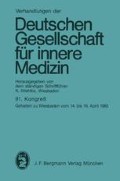Zusammenfassung
Das Therapieziel bei der Behandlung symptomatischer Bradykardien hat sich in den letzten lahren wesentlich gewandelt. Neben der sicheren Verhinderung des AdamsStokes’schen Anfalls und des plötzlichen Herztodes bei Patienten mit bradykarden Herzrhythmusstörungen soll durch eine differenzierte Schrittmachertherapie eine verbesserte Hämodynamik in Ruhe und bei Belastung erreicht werden. Durch den Einsatz ventrikelstimulierender Schrittmacher konnte die Prognose quoad vitam bei Patienten mit totalem AV-Block deutlich gebessert werden. Die Schrittmacherimplantation bei Patienten mit Sinusknotensyndrom erfolgt meist nicht aus vitaler Indikation, sondern dient zur Beseitigung der bradykardiebedingten Symptomatik und zur Verbesserung der körperlichen Leistungsfähigkeit. Ein befriedigendes hämodynamisches Ergebnis kann aber mit einem Kammerschrittmacher häufig nicht erreicht werden [2]. Hierzu ist vielfach ein vorhofbeteiligtes Schrittmachersystem erforderlich.
Access this chapter
Tax calculation will be finalised at checkout
Purchases are for personal use only
Preview
Unable to display preview. Download preview PDF.
Literatur
Alicandri C, Fouad FM, Tarazi RC, Castle L, Morant V (1978) Three cases of hypotension and synkope with ventricular pacing. Am J Cardiol 42: 137–141
Alt E (1984) Indikation und Erfolg der Schrittmachertherapie bei bradycarden Rhythmusstörungen. Herzschrittmacher 4: 184–190
Alt E, Wirtzfeld A (1983) Differentialindikation für physiologische Schrittmacher. Herzschrittmacher 3: 11–16
Benchimol A, Dumas A, Ligget S, Dimond EG (1965) Contribution of atrial to cardiac function at a fixed and a variable ventricular rate. Am J Cardiol 16: 11–20
Bergbauer M, Sabin G (1983) Hämodynamische Langzeitresultate der bifokalen Schrittmacherstimulation. Dtsch Med Wochenschr 108: 545–549
Gerckens U, Nitsch J, Luderitz B (1985) Funktionsstörungen von Kammer-Demand-(VVI) und AV-sequentiellen (DDD) Schrittmachern durch Muskelpotentiale. Dtsch Med Wochenschr (im Druck)
Griebenow R, Saborowski F, Hossmann V, Meier J (1985) Langzeitergebnisse der permanenten Vorhof-Schrittmacher-Therapie. Herzschrittmacher 5: 38–40
Hauser RG, Billhardt RA, Rosenbusch SW, Edwardts LM (1982) Noninvasive correction of pacing system malfunction by programming pacemakers. In: Feruglio GA (ed) Cardiac Pacing. Piccin Medical Books, Padua, p 785
Jolgren D, Fearnot N, Geddes L (1984) A rate-responsive pacemaker controlled by right ventricular blood temperature. Pace 7: 794–801
Jost M, Pfisterer M, Schelker D, Burkart F (1983) Reentry-Tachycardien. Ein häufiges Problem während physiologischer Herzstimulation. Schweiz med Wochenschr 113: 1675–1677
Laczkovics A (1984) The central venous blood temperature as a guide for rate control in pacemaker therapy. Pace 7: 822–830
Luderitz B (1980) Elektrische Stimulation des Herzens. Springer, Berlin Heidelberg New York
Markewitz A, Hemmer W, Funccius W, Kemkes BM (1984) Vorhofflimmern nach Implantation eines DDD-Schrittmachers. Herz/Kreislauf 5: 265–268
Mitrovic V, Neuss H, Schlepper M, Thormann J (1984) Hämodynamische Bedeutung der Koordination von Vorhof-und Kammersystole bei Tachycardien. Z. Kardiol. 75: 34–40
Nager F, Kappenberger L (1971) Hämodynamik nach Schrittmacherimplantation. Internist 18: 14–2
Narula OS (1971) Atrioventricular conduction defects in patients With sinusbradycardia. Circulation 44: 1096–1110
Nitsch J, Seiderer M, Bill U, Luderitz B (1983) Auswirkung unterschiedlicher Schrittmacherstimulation auf linksventrikuläre Volumendaten — Untersuchungen mit der Radionuklid-Ventrikulographie. Z. Kardiol 72: 718–722
Nitsch J, Seiderer M, Biill U, Luderitz B (1984) Kontraktionsablauf unter physiologischer und ventrikulärer Schrittmacherstimulation. Klin Wochenschr 62: 1132–1135
Parsonnet V, Furman S, Smyth NPD (1981) A revised code for pacemaker identification. Pace 4: 400–403
Rickards AF, Norman J (1981) Relation between QT interval and heart rate. Br Heart J 45:56–61 21. Rossi PR, Plicchi G, Canducci G, Rognoni G, Aina F (1983) Respiratory rate as a determinant of optimal pacing rate. Pace 6: 502–507
Rossi PR, Plicchi G, Canducci G, Rognoni G, Aina F (1983) Respiratory rate as a determinant of optimal pacing rate. Pace 6: 502–507
Saborowski F, Hossmann V, Griebenow R, Dundalek E (1982) Hämodynamische Befunde während atrialer und ventrikulärer Stimulation bei Patienten mit erkranktem Sinusknoten. Herzschrittmacher 2: 131–133
Samet P, Bernstein WH, Nathan DA, Lopez A (1965) Atrial contribution to cardiac output in complete heart block. Am J Cardiol 16: 1–10
Scheibelhofer W, Niederberger M, Kaliman J, Laczkovics A (1984) Synkope und Kollaps aufgrund retrograder Leitung — Nutzen der physiologischen Stimulation. Herz/Kreislauf 4: 219–223
Skinner NS, Mitchell JH, Wallace AG, Sarnoff SJ (1963) Hemodynamic effects of alterning the timing of atrial systole. Am J Cardiol 205: 499–503
Sowton E (1964) Hemodynamic studies in patients with artificial pacemakers. Brit Heart J 26: 737–742
Wirtzfeld D, Himmler FC, Klein G, Schmidt G, Seidel K, Alt E, Präuer HW (1982) Atrial pacing in patients with sick sinus syndrome: acute and long-term hemodynamic effects. In: Feruglio GA (ed) Cardiac Pacing. Piccin Medical Books, Padua, p 651.
Author information
Authors and Affiliations
Editor information
Editors and Affiliations
Rights and permissions
Copyright information
© 1985 J. F. Bergmann Verlag, München
About this paper
Cite this paper
Effert, S. et al. (1985). Symposium C Probleme der Herzschrittmacher-Therapie. In: Miehlke, K. (eds) 91. Kongreß. Verhandlungen der Deutschen Gesellschaft für innere Medizin, vol 91. J.F. Bergmann-Verlag. https://doi.org/10.1007/978-3-642-85458-3_7
Download citation
DOI: https://doi.org/10.1007/978-3-642-85458-3_7
Publisher Name: J.F. Bergmann-Verlag
Print ISBN: 978-3-8070-0352-8
Online ISBN: 978-3-642-85458-3
eBook Packages: Springer Book Archive

